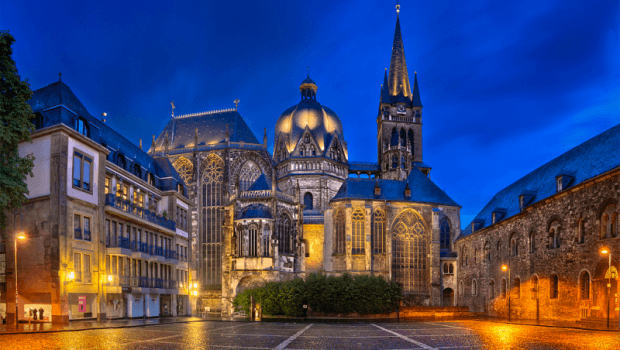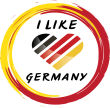
Aachen: the Crowning pedestal of Germany
From ancient times Aachen city has been known to the world as the coronation place of German Monarchy but recently it has transformed its image to the relaxing and Spa town of Germany.
Location:
Being at the western edge of the country in the state of North Rhine-Westphalia, Aachen happens to be located 61 kilometers to the west-southwest of the city of Cologne and share it borders with Netherlands and Belgium. This city is also known as one of the innovation hubs of Germany.
Weather:
Being on the westernmost edge, the city of Bad Aachen or Aix-la-Chapelle happens to experience a moderate climate all round the year, mostly damp weather, mild winters, and hot summers. In July and August, the daily mean temperature is 18 degrees Celsius, while it drops to 3 degrees Celsius in January. The city also enjoys sufficient amount of rainfall during the months of June, July, August, and December.
History:
The word Aachen was derived from the words “Aach” which directly means a river. The history of the city dates back to the Neolithic period, the Bronze Age and the Iron Age. Legend says that Aquae Granni, a Roman spa resort town, was founded by Grenus in 124 AD under the orders of Hadrian, a Roman emperor. Because of the hot springs present in the nearby area, The King of Franks made Aachen his residentiary town by building a castle in the town. Aachen had already started getting popular because of its springs that during the coronation ceremony of Pepin the Short when Charlemagne, his son, visited the town he fell so much in love with it that he made it a point to holiday in Aachen every year during winters. Within just a few years this town had become the political and economic hub of the Carolingian dynasty.
For many years all German kings who were chosen to reign over the country were all crowned in the city of Aachen, thus making it the Coronation pedestal town for Germany. The last king, who was crowned in Aachen, was Ferdinand I.
Then came the middle ages in which the city of Aachen focused on attaining the position of the most sought after town for trading purposes, mostly famous for trading in woolen clothes. With ongoing growth in the trading sector, the city also had to deploy its own soldiers to protect the traders from thieves or road diggers.
Because of being titled as the imperial city, Aachen also enjoyed certain political privileges, especially during the troubling years in the whole of Europe. Being the most important city of the Roman religious body, Aachen also became the site of most of the church councils, present in Europe during the middle ages.
Being the religious hub of Roman Empire, Aachen was also famous for producing some famous manuscripts. This town was known for producing massive amounts of manuscripts flooded with religious, legal, economic and political information describing the middle age era of the region.
From the 16th century, Aachen started losing its powerful grip due to constant invasions from Netherlands because of which the kingdom had to switch to Frankfurt as its coronation town. These invasions were just the beginning of the downfall of the town as after these the town also started losing its popularity amongst religious leaders, thus leading them to look for other options to set up their councils. This devastation further resulted in the famous fire incident in the year 1656, which left half of the town in ashes. But after its culmination by the French, the town started becoming the site for important treaties of the 19th century. With the industrial revolution spreading throughout Europe, Aachen also became an important industrial town for France, thus resulting in much needed developmental strategies following the construction of a good railway network across the town connecting it with neighboring cities.
Presently, the city of Aachen has transformed into one of the modern cities. It also happens to host one the famous Universities for Technology in the world.
About the city:
Aachen, covering a total area of 160.85 square kilometers, is inhabited by around 240,086 people, of whom 13.6% are foreign-born residents. Divided into seven authoritative territories or boroughs, such as Aachen-Mitte, Eilendorf, Laurensberg and Brand, the city has its own territory council, territory leader, and territory authority. Presently being a part of a democratic nation, these leaders are elected by the local population by a proper election process.
Being the technology hub of the nation, the IT sector of the city has mostly flourished over the years. Other than the IT sector, the city also happens to host many mining industries. Therefore, the city is not just technologically powerful but also happens to produce a large amount of other goods as well, namely textiles, plastics, machinery and metal products.
Since ancient times Aachen has always been inclined towards doing or inventing something new. In 1372, Aachen was the first city to produce minted coins. Later, it also became the first city to adopt the nightlife culture by constructing the first ever disc equipped with the first ever Disc Jockey in the world.
The city has also been home to uncountable renowned people, like Edith Frank, the mother of Anne Frank; David Garrett, the famous classical violinist; French chemist and physicist Henri Victor Regnault; athlete Friedrich Hendrix and others.
How to travel?
Aachen is well connected by a huge network of rails, roads, and planes. The city has four small stations, one main airport and several bus stands connecting the seven districts of the city and also connecting the city to the major neighboring cities around Germany, Netherlands, and Belgium. High-speed InterCity Express trains run from Brussels to Frankfurt through Cologne, which is linked to Aachen’s central railway station. From Paris to Cologne also runs Thalys trains, stopping for a while at Aachen. The Autobahn A544, A44, and A4 link Aachen with other places, and can be used by tourists who want to reach Aachen by car. 28 kilometers to the northwest of Aachen is the Maastricht Aachen Airport.
Due to longer distances, the locals prefer traveling via public transport in the city.
Why Visit?
The world’s first city to mint coins and the first one to have a discotheque with a DJ, Aachen awards the International Charlemagne Prize every year on Ascension Day at the Aachen Rathaus or Town Hall to personalities for their exceptional contribution to Europe’s unification. Pope Francis in 2016 and German Chancellor Angela Merkel in 2008 are among those who have been awarded till date.
TC Grün Weiss, the biggest tennis club in Aachen, hosts the Lambertz Open by STAWAG, an annual tennis tournament that is part of the Association of Tennis Professionals (ATP) Challenger Tour. The World Equestrian Festival is an attraction for fans of horse sport, while a visit to the famous Aachen Christmas Market around the Aachen Town Hall and Cathedral is an absolute must.
Major Attractions:
With being one of the most historically enriched towns, the city offers many major attractions. Like:
- Aachen Cathedral: Built by Charlemagne, this is the largest Cathedral on the northern Alps. Styled according to the Carolingian Dynasty, the walls of the Cathedral are laid with marbles. It is also the resting place for Charlemagne’s remains. Being the only coronation palace for many kings and queens of Germany, this place has been titled as a World Heritage site. Also being an official pilgrimage spot, the Cathedral is visited by Romans and Germans both from around the world.
- Cathedral Treasury: The place is known to house a collection of ancient formularies of worship. Other than these, the place also happens to preserve some old manuscripts relating to the religious practices of the time and some objects used by the Monarchs of the region.
- Aachen Rathaus: This is the city hall of the town. The city hall hosts a museum inside which has artifacts hailing from the monarchy period of the region. Other than the museum, this is also where the Mayor of the town, with its councils, happens to operate from. It is also the place where the Charlemagne Prizes are conducted.
- Elisenbrunnen: Once used to be a bathing place for royals, today the only thing left of it is two fountains. Though most of this place was torn apart by the world war, the ruins of it are still eye pleasing to watch.
- Market: The market around city hall is a must visit if anyone is interested in buying local goods. Also, it is an excellent place where one gets to witness cultural flavors of the region.
- Aachen Printen: This is a famous local delicacy that is a must try for anyone who wants to have a taste of the traditional food. Large flat loaves of bread sweetened with syrup from sugar beets taste yummy.
- Ludwig Forum Forum International Art: This factory is famous for presenting international modern art from around the world. It is a must see for any contemporary art lover.
What Else is Around?
- Michael’s Church
- The Grashaus
- The Ponttor and the Marschiertor
- The Klinikum Aachen
With lots to explore and see around, Aachen is truly one of the remarkable places that you should visit when you are in Germany. Ranked eighth among the most innovative German cities in 2009, this historically and technologically significant city of Aachen is worth visiting. So, go ahead and plan a visit to this place with your family and enjoy exploring this amazing city. You would love it for sure!
